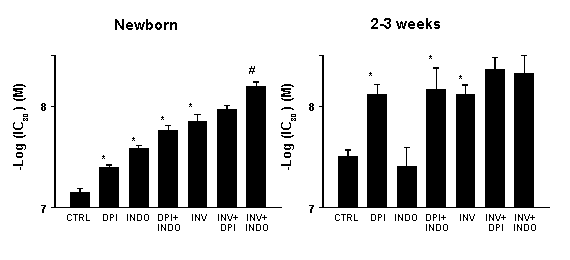| pA2 online © Copyright 2004 The British Pharmacological Society |
090P
GKT, University of London Winter Meeting December 2003 |
|
Role of
cyclooxygenase-derived superoxide in the postnatal pulmonary arterial
maturation to NO
A. Cogolludo, L. Moreno, F. Lodi, 1A. Briones, 1E. Vila, J. Tamargo, F. Perez-Vizcaino. Depts. of Pharmacology. Univ. Complutense de Madrid and 1Autónoma de Barcelona, Spain. |
|
Nitric oxide (NO)-induced pulmonary vasodilation increases during the first days after birth contributing to the adaptation of the pulmonary circulation to the extrauterine life. Cyclooxygenase-1 (COX-1)-dependent inhibition of neonatal NO bioactivity seems to be involved in this maturation (Perez-Vizcaino et al., 2002). The aim of this study was to analyse the role of COX-derived superoxide in this process.
Endothelium denuded intrapulmonary artery rings (0.5-1 mm of internal diameter) from male piglets of 3-18 h (newborns, NB) or 2-3 weeks of age (2w) were incubated in Krebs solution for isometric force recording. Arteries were stimulated with the thromboxane A2 mimetic U46619 (0.1 µM) and relaxed with increasing concentrations of NO (2-200 nM). In order to limit the interaction of NO with the adventitial layer, some arteries were inverted (INV), exposing the luminal surface outwards. Levels of superoxide were measured by the reduction of nitroblue tetrazolium (NBT). Localization of COX-1 was detected by immunohistochemistry with a confocal microscope.
NO was more potent in relaxing 2w than NB arteries. The membrane NADPH oxidase inhibitor diphenylene iodonium (DPI, 10 µM) potentiated NO-induced relaxation at both ages, whereas the COX inhibitor indomethacin (Indo, 10 µM) only potentiated it in NB arteries (Fig. 1). The effects of Indo and DPI were additive in NB. Furthermore, Indo prevented the inhibition of NO-induced relaxation elicited by the SOD inhibitor diethyldithiocarbamate (DETCA, 1 mM) in NB but not in 2w animals. In INV arteries the relaxant response to NO was markedly potentiated at both ages. In INV arteries from NB animals Indo produced a further potentiation (Fig. 1).
In arteries exposed to DETCA, superoxide production was reduced by Indo only in NB arteries (5.7 ± 1.1 vs 9.7 ± 1.4 arbitrary units·mg-1 in Indo and untreated arteries, respectively). COX-1 was located both at the endothelium and the adventitial layer by immunohistochemistry in both ages and NBT stained mainly the adventitial layer.

Fig.1. Potency (-log IC30) of NO to relax NB and 2w pulmonary arteries. Means ± s.e. means of 5-12 experiments. * P < 0.05 vs control (CTRL) and # P < 0.05 vs INV (Newman-Keuls' test).
All these results suggest that different sources of superoxide, mainly COX-1 and NADPH oxidase, modulate the NO-induced relaxation in the NB. In contrast, COX-1 is not involved in older animals. The adventitial layer may play a key role in superoxide-induced NO inactivation. Thus, COX-1-derived superoxide may be responsible, at least partly, for the maturation of NO bioactivity during the first days of extrauterine life.
Perez-Vizcaino et al., (2002). Am. J. Physiol. 283, L839-L848.